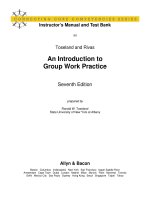An introduction to human services 7th edition woodside test bank
Bạn đang xem bản rút gọn của tài liệu. Xem và tải ngay bản đầy đủ của tài liệu tại đây (127.24 KB, 5 trang )
CHAPTER 2 TEST ITEMS
Multiple Choice
1.
Hippocrates, a doctor in the third century B.C., was one of the few professionals who
believed that problem behavior was a function of
a.
b.
c.
d.
chemicals
evil spirits
heredity
natural causes
ANS: D
2.
Relief for the poor was the responsibility of which provider during the Middle Ages?
a.
b.
c.
d.
the church
feudal lords
the government
institutions
ANS: A
5.
PG: 31
All of the following are features of the Elizabethan Poor Law EXCEPT
a.
b.
c.
d.
a classification system for dependents according to their ability to work
compulsory taxation to raise funds to help
inhumane treatment for those in institutions
responsibility for “have nots” was first with the family
ANS: C
4.
PG: 29
PG: 31
The dramatic change in the care of the mentally ill that occurred by the end of the 18th
century and resulted in more humane treatment is known as
a.
b.
c.
d.
the first revolution in mental health
a time of change
the decade of victory
the mental health movement
ANS: A
PG: 33
5.
Proponents of laissez faire economics and Social Darwinism discouraged human service
provisions by the
a.
b.
c.
d.
asylums
church
government
private sector
ANS: C
6.
The concept of “less eligibility” was introduced in 1834 to
a.
b.
c.
d.
7.
limit assistance
determine who was eligible for human services
promote institutional reform in prisons, almshouses and asylums
emphasize the benefits of social engineering
ANS: A
PG: 34
By the 1850s, special institutions for the blind, the mentally ill, criminals, and other
groups were established because of the belief that
a.
b.
c.
d.
public agencies should assume more responsibility for these groups
reform, rehabilitation, and education were possible
the condition of these people would improve in pastoral settings
“less eligibility” demanded better treatment
ANS: B
8.
PG: 36
Large houses in slum areas that served as community centers housed workers known as
a.
b.
c.
d.
friendly visitors
human service professionals
social engineers
volunteers
ANS: C
9.
PG: 35
PG: 40
The settlement house movement is best known for its belief that
a.
b.
c.
d.
the best way to achieve reform was through social engineering
the private sector had a critical role in the provision of human services
the social philosophies of the 19th century helped the deserving poor
friendly visiting was the most successful helping strategy of the time
ANS: A
10.
Significant developments in the early 1900s, a period known as the sociological era,
included all EXCEPT
a.
b.
c.
d.
new treatment modalities for the mentally ill
a re-examination of the causes of poverty
the development of the profession of social work
the professionalization of human services
ANS: A
11.
clients’ rights
mental health legislation
the presidential leadership during the 1960s
welfare reform
ANS: D
the creation of NIMH and funding for human service education programs
the professionalization of mental health workers and educational opportunities
new mental health workers and programs to train them
a national mental health program and non-medical workers
ANS: D
PG: 44
To help states develop programs for increased training, research, and practice, legislation
to improve mental health created the
a.
b.
c.
d.
National Institute of Mental Health
Joint Commission on Mental Health
Department of Health, Education, and Welfare
Action for Mental Health initiative
ANS: A
14.
PG: 44
The Joint Commission on Mental Illness and Health made two recommendations that
directly affected the human service movement
a.
b.
c.
d.
13.
PG: 40
The beginnings of the human service movement can be found in the impact of all
EXCEPT
a.
b.
c.
d.
12.
PG: 39
PG: 44
The idea behind the passage of the Community Mental Health Centers Act of 1963 was
to
a.
b.
c.
d.
serve Viet Nam veterans
create a setting for a new type of mental health worker
provide an array of services to the population
eradicate mental illness among those living in poverty
ANS: C
15.
Human services flourished under all but ONE of the following presidents
a.
b.
c.
d.
Johnson
Kennedy
Reagan
Roosevelt
ANS: C
16.
Fair Deal
Great Society
New Deal
New Federalism
ANS: B
PG: 47
President Carter involved five departments in reorganizing the federal executive branch
to include two new departments
a.
b.
c.
d.
Children’s Services and Education
Education and Social Services
Health and Human Services and Education
Health and Rehabilitative Services and Education
ANS: C
18.
PG: 50
Promoting the rights of the poor, improving employment opportunities for minorities, and
eradicating poverty were the goals of the
a.
b.
c.
d.
17.
PG: 46
PG: 49
The establishment of professional human services organizations served many purposes
including
a.
b.
c.
d.
the development of funding opportunities
influencing legislation
determining who received services
the regulation of a profession or its workers
ANS: D
PG: 46
19.
A major component of the Welfare Reform Legislation in 1996 was to
a.
b.
c.
d.
provide child care, food, and housing
turn welfare over to the states
mandate new procedures for collecting child support
subsidize child care AFDC, and energy assistance
ANS: B
20.
PG: 51
The Medicare Prescription Drug, Improvement, and Modernization Act of 2003 was
passed to
a.
b.
c.
d.
establish a method for verifying customers’ enrollment in Medicare
provide an easy way to obtain prescriptions
prevent prescription drug abuse
provide outpatient prescription drug benefits for individuals on Medicare
ANS: D
PG: 54
Discussion
1.
Describe the role of the church in the early history of human services.
PG: 29
2.
Discuss the importance of the Elizabethan Poor Law to human services in both
England and the United States.
PG: 31
3.
Differentiate between the approaches of the organized charity movement and the
settlement house movement to helping.
PG: 38-39
4.
Analyze the impact of 20th century legislation and presidential administrations on
service delivery.
PG: 43
5.
PG: 49
Trace the dismantling of the welfare state.









